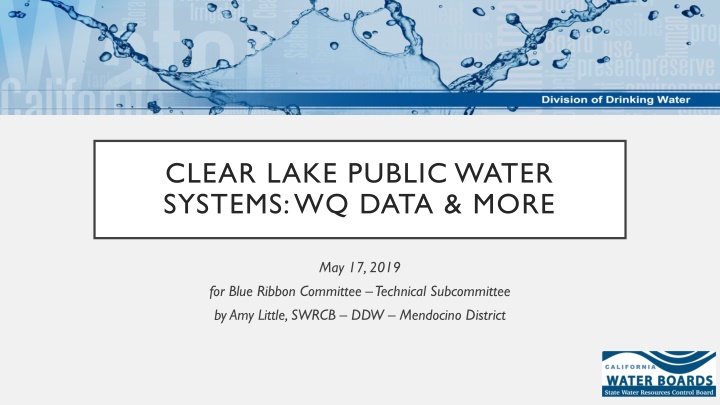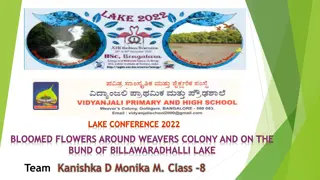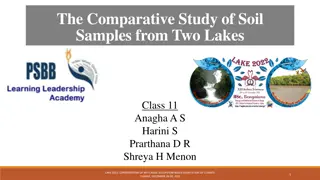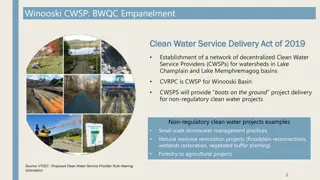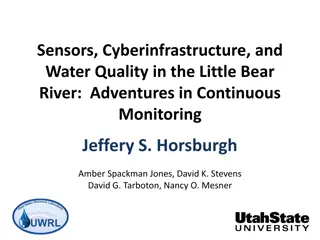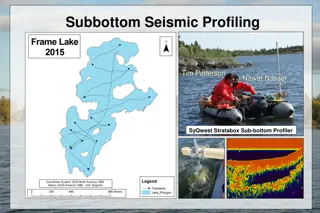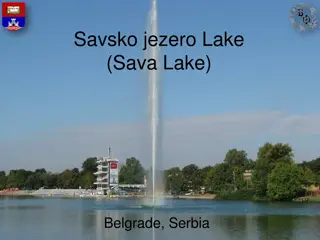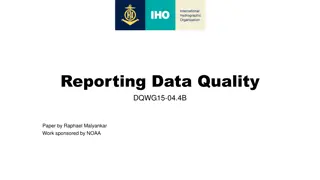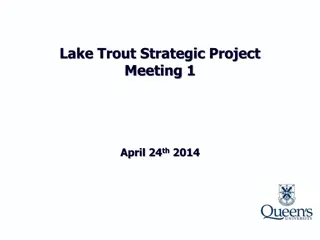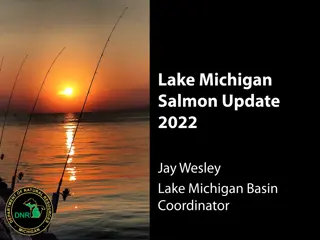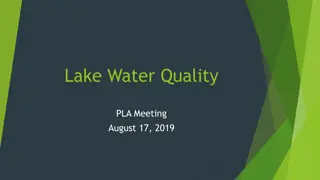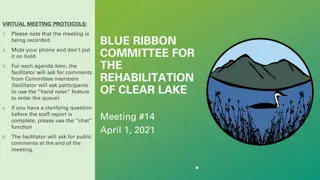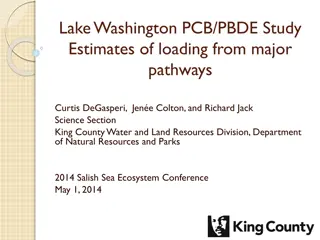Clear Lake Public Water Systems - Water Quality Data
Public Water Systems around Clear Lake, CA, serve approximately 38,000 people. Extensive water quality monitoring is conducted to meet state and federal standards. The data includes pH levels from 1984 to 2017 and poses questions for the Technical Subcommittee regarding conveying water quality parameters effectively.
Download Presentation

Please find below an Image/Link to download the presentation.
The content on the website is provided AS IS for your information and personal use only. It may not be sold, licensed, or shared on other websites without obtaining consent from the author.If you encounter any issues during the download, it is possible that the publisher has removed the file from their server.
You are allowed to download the files provided on this website for personal or commercial use, subject to the condition that they are used lawfully. All files are the property of their respective owners.
The content on the website is provided AS IS for your information and personal use only. It may not be sold, licensed, or shared on other websites without obtaining consent from the author.
E N D
Presentation Transcript
CLEAR LAKE PUBLIC WATER SYSTEMS: WQ DATA & MORE May 17, 2019 for Blue Ribbon Committee Technical Subcommittee by Amy Little, SWRCB DDW Mendocino District
INTRODUCTION Public Water System (PWS) is defined as a system for the provision of water for human consumption through pipes or other constructed conveyances that has 15 or more service connections or regularly serves at least 25 individuals daily at least 60 days of the year. (Section 116275 of CA Health & Safety Code) 18 public water systems rely on Clear Lake as its source to supply treated water to approximately 38,000 people around the lake. There are at least 18 intakes in different locations around the lake with different types of surface water treatment in place designed to meet state and federal requirements of the Safe Drinking Water Act.
EXTENSIVE WATER QUALITY MONITORING BY PWS Potentially useful water quality data is available to support assessments and more Minimum monitoring required in source water for community PWS with more than 1,000 connections TYPICALLY includes: Monthly bacteriological monitoring for total organic carbon, total coliform and E. coli Annual: inorganics, nitrate, secondary standards (however, these are being moved to finish) Triennial: nitrite, volatile organic chemicals, synthetic organic chemicals Less frequent: radiological Note: Monitoring can vary tremendously (initial requirements, treatment dependent, and more) Secondary standards includes constituents related to the aesthetics of the water (e.g. iron)
GOAL Create a dialogue with Blue Ribbon Committee Technical Subcommittee with newly compiled water quality information QUESTIONS FOR TECH SUB-COMMITTEE 1. Are you interested in these water quality parameters? 2. Is so, which ones? See Table 2 3. How can we convey these parameters in a meaningful way?
EXAMPLE WQ PARAMETER: PH Clear Lake Time series of pH (1984-2017) compiled from all public water systems around Clear Lake, CA 12.0 10.0 8.0 6.0 4.0 2.0 0.0 1984 1985 1986 1987 1988 1989 1990 1991 1992 1993 1994 1995 1996 1997 1998 1999 2000 2001 2002 2003 2004 2005 2006 2007 2008 2009 2010 2011 2012 2013 2014 2015 2016 2017 5th perc 95th perc avg min max
DIFFERENT WAYS TO PRESENT pH 12 10 8 6 4 2 0 1980 1985 1990 1995 2000 2005 2010 2015 2020
STILL MORE ON PH Clear Lake Time series of pH by Month (1984-2017) 12.0 10.0 8.0 6.0 4.0 2.0 0.0 JAN FEB MAR APR MAY JUN JUL AUG SEP OCT NOV DEC 5th perc 95th perc avg min max
Maximum E. coli concentration at drinking water intakes for the Lower, Upper, and Oaks arm of Clear Lake 1,800 LOWER 1,600 OAKS UPPER 1,400 1,200 Maximum E. coli , MPN 1,000 800 600 400 200 0 2008 230 20 140 2009 231 -2 10 2010 539 -2 689 2011 659 10 37 2012 921 141 236 2013 344 8 44 2014 1700 16 99 2015 225 20 921 2016 291 22 47 2017 173 50 308 2018 172 4 75 2019 194 23 41 LOWER OAKS UPPER ND ND ND ND Not Detected
Maximum E. coli concentration at drinking water intakes for the Lower, Upper, and Oaks arm of Clear Lake by Month (2008 - Feb 2019) 1800 1600 1400 Maximum E. coli, MPN 1200 1000 800 600 400 200 0 JAN 539 49.6 309 FEB 224.7 22.8 52.9 MAR 658.6 21.6 307.6 APR 30 9.8 29.8 MAY 44 2 15.8 JUN 66.3 9.8 37.3 JUL 230 3.1 35.5 AUG 172.2 31.7 95.9 SEP 1700 16 40 OCT 64.4 6.3 149.7 NOV 55.4 11 920.8 DEC 920.8 141.4 235.9 LOWER OAKS UPPER LOWER OAKS UPPER
Lower Arm median (E.coli MPN) <1 <1 <1 1 1 1 <1 1 1 1 Upper Arm median (E.coli MPN) <1 <1 <1 <1 <1 <1 <1 <1 <1 1 Oaks Arm median (E.coli MPN) <1 <1 <1 2.0 1 1 2 1.5 6.3 2.0 Year 2008 2009 2010 2011 2012 2013 2014 2015 2016 2017 Table 1. The median E. coli density, most probable number (MPN) was calculated for each arm of Clear Lake. A bold italicized value indicates that fewer than ten samples were collected.
PART 2: PWS SOURCE WATER QUALITY EFFORTS
2017 EFFORTS TO UNDERSTAND AND IMPROVE SOURCE WATER QUALITY BY PWS In 2017, hired Corona Environmental Consultants to review and summarize all Lake plans/efforts to improve source water quality in Clear Lake, CA. [Plan Review | Plan Matrix]. In this report, projects were prioritized by PWS (top three listed): 1. Physical treatment (aeration and sonication) at the intake 2. Nutrient Input and Cycling Study and Chemical Treatment 3. Storm Water System Improvement Study To learn about these projects and key lessons learned, contact Tarrah Henrie of Corona In 2018, two public water systems applied for DWSRF funding based on the outcome from the efforts above: Cal Water applied for a nutrient cycling project and Golden State Water applied for an aeration project.
PART 3: MENDOCINO COMPLEX IMPACTS?
POTENTIAL LONG TERM IMPACTS TO PWS DUE TO RECENT WILDFIRES During meeting in the Fall of 2018, David Cowan, Director of Lake County Water Resources Department, stated that approximately 60% of the county has burned in the last four years. Dr. Amanda Hohner (WRF Report #4590) suggests in post-wildfire conditions that higher levels of natural organic matter in source water quality may lead to disinfection byproduct compliance issues. We anticipate an increase in turbidity, nutrients, total organic carbon, and more [USGS info]
Total Organic Carbon (TOC) in Clear Lake, mg/L (pre- and post- Sept 2013) 18.0 16.0 Average TOC (pre-2013): 4.1 mg/L Average TOC (post-2013): 5.4 mg/L 14.0 12.0 Total Organic Carbon, mg/L 10.0 8.0 6.0 4.0 2.0 0.0 JAN FEB MAR APR MAY JUN JUL AUG SEP OCT NOV DEC pre9.2013(min) pre9.2013(avg) pre9.2013(max) post9.2013(min) post9.2013(avg) post9.2013(max)
Significant recent increase in average HAA5 concentration, from 29.8 ug/L to 41.7 ug/L, ~40% increase. maximum contaminant level = 60 ug/L
PART 4: PWS PLAN FOR EMERGENCIES
PLANNING FOR EMERGENCIES In May 2018, public water systems and our Division attended a Water Quality Failure Workshop, exploring potential emergency scenarios, including: Cyanotoxins present in drinking water delivered to customers Filters are unable to meet turbidity performance standards Elevated manganese and ammonia concentration in source water (Fall 2017) System-wide pressure loss (usually limited to a few customers) Elevated disinfection byproducts in drinking water delivered to customers (future) This list was an exercise. There are additional efforts underway by PWS, including a mutual aid agreement.
HOW TO SUPPORT PWS IN CLEAR LAKE? Activity Recommendations and Next Steps Source Improvements Support funding to find effective and holistic solutions to reduce nutrient inputs and mitigate the impacts of cyanobacteria blooms. The proposed projects take a multi- pronged approach towards improving water quality in Clear Lake. These projects seek to address some of the most pressing issues on Clear Lake towards meeting the nutrient TMDL, improving source water quality and reliability, and improving knowledge of phosphorus dynamics in Clear Lake to support on-going management strategies. Three priority projects were identified by Corona Environmental Consulting that would accomplish the above: Improve source water quality in alignment with recent projects identified Phosphorus loading study ($386,000) Physical treatment: aeration/ultrasonic installation and study ($500,000) Green Infrastructure and Road Improvements for Stormwater Management ($880,000) Recommend Tarrah Henrie or Golden State Water Company present to Blue Ribbon Committee Technical Subcommittee to explore this topic further. Efforts to decrease disinfection byproducts Support match funding needed to conduct a project that will support utilities in identifying ways to reduce organics and corresponding disinfection byproducts. Dr. Amanda Hohner, an assistant professor at Washington State University, would be the principal investigator on a Water Research Foundation project that would do the following: Conduct a study to improve our understanding of organics in source water and evaluate potential treatment options to reduce organics Describe source water characteristics, specifically the organic composition Optimize organic reductions by examining which combination of pre-oxidants yields the lowest disinfection products Examine the conversion of granular activated carbon filters into biofilters; recent research suggests ozone with biologically active granular active carbon filters can enhance organic reductions Some utilities have expressed an interest in this project. No funding has been identified to support it at this time. Meet and inform public water systems Provide Clear Lake public water systems an update on efforts underway to improve source water quality every five years. Further, consider an interactive discussion, as the Clear Lake public water systems communicate with approximately 38,000 people multiple times a year and participate in a watershed sanitary survey every five years. Discuss source water quality improvements, including progress and direction on projects Recommend a group informative meeting (and interactive discussion) is held between all water quality representatives of Clear Lake public water systems and the Regional Board, or other knowledgeable party, every five years.
HOW TO SUPPORT PWS IN CLEAR LAKE? Activity Recommendations and Next Steps Support the development of a strong learning-based operator program with local educational institutions, including high schools. Contact Paul Harris, Utilities Superintendent for City of Lakeport, to learn about current efforts underway. Provide financial assistance to a Clear Lake operator recruitment and retention program. The program would support Clear Lake surface water system operators by paying for contact hours which is required for treatment certification and all certification exams and advertising to increase job visibility. Support a apprentice program that involves an operator (with a certification of at least T4/T5 for five years) paired with an apprentice operator (any level) residing or employed in Lake County. The Division could assist (need to verify) by providing both parties with contact hours (maximum 12 hours earned; three 4-hour sessions) and developing the topics that would be discussed and reviewed (e.g. safety, chemical dosage calculations, optimizing unit treatment processes). Career development for operators Add treatment tools to assist operators Provide financial assistance to Clear Lake public water systems that would support monitoring or optimizing treatment to reduce current and emerging contaminants. Examples of eligible support would allow public water systems to apply for funds in order to do the following: Monitoring and instruments can help a water system anticipate potential issues a. b. Monitor for microcystins or nitrogenous based disinfection byproducts. Purchase equipment to verify treatment processes are optimized to reduce organics (e.g. bench top equipment that measures UV transmissivity or laboratory charge analyzer) Install or upgrade a treatment process to reduce organics or emerging contaminant c. Other Recommendations a. Support table top emergency exercises for water quality failures every three years for Clear Lake public water systems. b. Consider including total organic carbon in future watershed models to assist public water systems.
SOURCES OF INFORMATION 2019 Clear Lake Public Water System Survey, State Water Resources Control Board Division of Drinking Water Water Quality Database, Corona Environmental Consulting reports, including 2018 Task 2 final report and Golden State Water Company: Clear Lake Watershed Sanitary Survey Update Source Water Quality Improvement Grant Applications, Water Research Foundation Emerging DBPs Factsheet, Water Research Foundation Web Report #4590 Wildfire Impacts on Drinking Water Treatment Process Performance: Development of Evaluation Protocols and Management Practices, CA EPA Regional Water Quality Control Board Central Valley Region Clear Lake Nutrient Total Maximum Daily Load Control Program 5-Year Update (2012), Effects of Wildfire on Drinking Water Utilities and Best Practices for Wildfire Risk Reduction and Mitigation, WRF & EPA, Web Report #4482 (2013), CALFIRE web-based statistical reports, Big Valley Band of Pomo Indians Clear Lake water quality dashboard and Clear Lake public water system permit reports.
